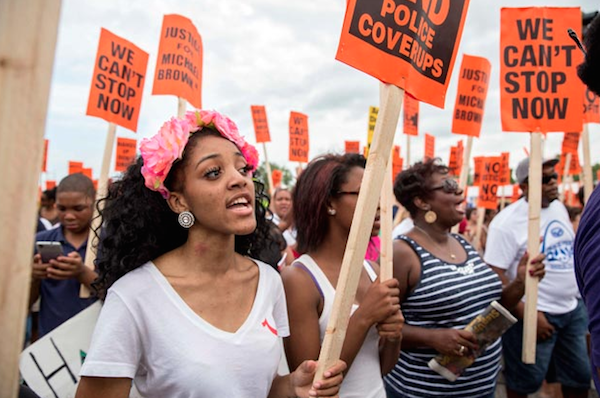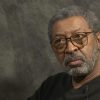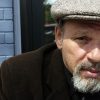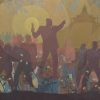
Truthout obtained this figure by examining news reports from January 1 to August 6 of 2014. On August 10, protests opposing the police killing of unarmed black teenager Michael Brown began. You can view the data Truthout compiled here.
| Location | # of individuals Shot by police | Description of Incident | Name of Individual Shot | Link to news story |
|---|---|---|---|---|
| St. Louis | 1 Killed | Car Chase | Stephon Averyhart | http://bit.ly/1nUUacx |
| Jennings, Mo. | 1 Shot | Drug Deal | Brothel George | http://bit.ly/1sYqzCc |
| St. Louis | 1 Shot | Robbery | ? | http://bit.ly/1pn7qq7 |
| Woodson Terrace, Mo. | 1 Shot | Car Chase | Damon Brischetto | http://bit.ly/1BaBr4U |
| Washinton Park, Il. | 1 Shot | Robbery | ? | http://bit.ly/1qmVNVj |
| St. Louis | 1 minor Shot (17 year old) | Responding to Robbery | Keon Davis | http://bit.ly/1lGY8uf |
| Fenton, Mo. | 1 Killed | Robbery | Claudell Webb Jr. | http://bit.ly/1tYC5jD |
| University City, Mo. | 1 Shot | Drug Deal | Kelvin F. Dorries Jr. | http://bit.ly/1lxQKRx |
| St. Louis | 1 Shot | Robbery | Deonte Phillips | http://bit.ly/1sYjMZj |
| Bel Ridge, Mo. | 1 Shot | Drug Deal | Joshua Martin | http://bit.ly/1BaylOl |
| South St. Louis | 1 Shot | Drug Deal | ? | http://bit.ly/Z6nVln |
| Pine Lawn, Mo. | 1 Killed | Traffic Stop | ? | http://bit.ly/1ripOFX |
| Granite City, Il. | 1 Killed | Called 911 | Stephen S. Minch | http://bit.ly/1nwwDii |
| Granite City, Il. | 1 Shot | Attempted Murder | Thomas E. Noser | http://bit.ly/1qZdoPl |
| East. St. Louis | 2 Shot | traffic Stop | ? | http://bit.ly/1lGUSiG |
In the vast majority of incidents where the race of an individual shot by police was known, the individuals were black. Truthout was not able to determine how many (if any) of these police shootings were “justified” because data concerning police shootings is so limited.
Police shootings, along with other uses of force by the St. Louis area police, are not a new development. In Ferguson, seven active or former officers have now been named in civil lawsuits for excessive use of force; and in March 2014, two officers with the St. Louis Police Department severely beat a man with disabilities. In another recent civil case, an amount of over $800,000 was awarded to a victim of excessive force by the St. Louis Metropolitan Police Force.
In 2012, US District Judge Carol Jackson stated that the St. Louis Board of Police Commissioners may be “deliberately indifferent” or even tacitly approving of a “widespread persistent pattern of unconstitutional conduct.” In a separate 2010 federal civil lawsuit, which accused the St. Louis police of excessive force, the victim’s lawyer cited statistics showing that the St. Louis internal affairs investigators sustained only one of 322 citizens’ physical abuse complaints against police from 1997 to 2002.
And still, the department seems to be subject to an astonishingly low level of oversight. Dan Gregor, interim executive director of the National Lawyer’s Guild (NLG), told Truthout, “We largely give our police forces carte blanche until they mess up . . . It shouldn’t be the assumption of any state agency that they’re perfect until proven otherwise.”
To delve deeper into the impacts of such “carte blanche” permission, Truthout contacted psychologist Dr. Philip Zimbardo, responsible for the famous Stanford Prison Experiment. The Stanford Prison Experiment involved assigning ordinary college students one of two roles: mock prison guard or mock prisoner. The experiment soon found the “guards” behaving in such shockingly cruel and demeaning ways toward the “prisoners” that the experiment had to be terminated prematurely. Zimbardo told Truthout that the police response to the Ferguson protests were carried out through a similar logic.
“When police are armed with antiprotest weapons and shields to protect them from anticipated assaults by protesters, they create a war zone, not a peace zone, in which ordinary citizens become ‘the enemy,’ ” Zimbardo said. “We saw this in the South with police ‘protecting’ white citizens from black civil rights protesters who were simply demanding their rights . . .We saw how easily and quickly police lost their composure and reacted like mindless thugs.”
Zimbardo noted that racist police violence is not confined to Ferguson, referencing “the recurring episodes of brutal treatment by police in most towns in America.”
NLG’s Gregor, who served as a legal observer at the Ferguson protests, characterized law enforcement’s response as “completely over the top, shock-and-awe-style policing.” He remarked, “The only ‘calm’ that needed to be kept for 95 percent of my time down in Ferguson for over a week, was the calm of the police.”
Gregor witnessed 20 to 25 canisters of teargas fired at a group of 40 to 50 protesters.
“My reaction was, we really don’t each need our own teargas canister,” Gregor said.
When asked about how to improve police accountability, Gregor said, “I think there are lots of things that could be done to improve accountability,” but he recommended, “mandatory body cameras for which the devices, the content, and the recording is somehow monitored and made available to objective third parties.”
Gregor also suggested civilian review boards, but had some criticisms: “Some of them have done great work, and some of them have been functionally just a tool of the police department or the state. I’ve read reports where some of these review boards were clearing 97 or 98 percent of all complaints as unsubstantiated or unfounded. I’m sure that some of the complaints are unsubstantiated, but it’s impossible for me to believe that 98 percent are completely baseless.”
Looking Abroad for Comparison
Although there are problems inherent in the institution of policing the world over, the racist militarism seen in US police forces is particularly insidious. For comparison, consider an analysis conducted by The Economist, which concluded that in 2013, British police fired their weapons three times only; and just once in 2012. The Economist further noted, “Even after adjusting for the smaller size of Britain’s population, British citizens are around 100 times less likely to be shot by a police officer than Americans.”
One crucial difference is that in the UK, only specialist armed response teams are given firearms.
Dr. Peter Squires, professor of criminology and public policy at the University of Brighton in the UK, told Truthout, “The justification for specialist armed response is that it is specialist and very highly trained; to generalize armed policing would inevitably dilute that standard.”
Asked if not arming police hampers their safety, Squires responded, “Very few UK police officers are killed on duty in situations where a weapon might have helped.” Even for situations in which a weapon could have protected a police officer, “One would need to balance the additional risk of police firearm errors and misuse.”
Regarding law enforcement’s use of crowd suppressants like tear gas, pepper spray, rubber bullets and flashbangs at Ferguson, Squires commented, “I think rubber/plastic bullets have only been used in public order incidents once in mainland Britain . . . flashbangs and stun grenades [are] very seldom used except in armed entry/hostage type incidents. Very rare.”
Even in the UK, Squires says, it can be seen how “tooling up” (arming police with more – and more dangerous – weapons) affects behavior. Pepper spray and Tasers are increasingly being granted to police in the UK, according to Squires. Inevitably, they’re also being used more often. And that’s not a good thing: “In public order context, weapon use seems chiefly to exacerbate crowd disorder and therefore counterproductive,” he says.
There are many reasons why police in the United States are particularly prone to violence. Squires cites the United States’ “race ‘faultline’ ” as a key one: Police target and shoot black people; it is an ingrained historical practice. He also cites the fact that the United States is simply a more violent culture than many others – and not because it is innately violent. The fact is, Squires notes, “Unequal societies are always more violent than more egalitarian ones.”















